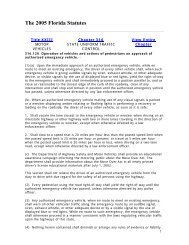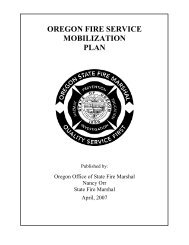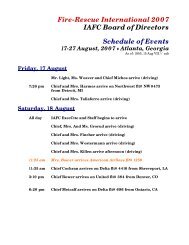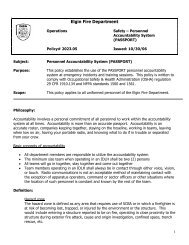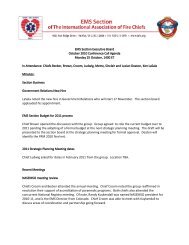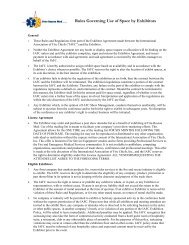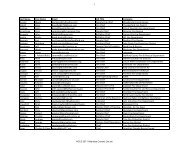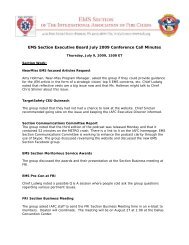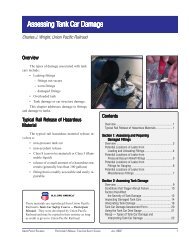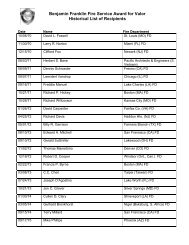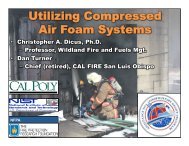Effects of Sleep Deprivation on Fire Fighters and EMS ... - NAEMT
Effects of Sleep Deprivation on Fire Fighters and EMS ... - NAEMT
Effects of Sleep Deprivation on Fire Fighters and EMS ... - NAEMT
Create successful ePaper yourself
Turn your PDF publications into a flip-book with our unique Google optimized e-Paper software.
<str<strong>on</strong>g>Effects</str<strong>on</strong>g> <str<strong>on</strong>g>of</str<strong>on</strong>g> <str<strong>on</strong>g>Sleep</str<strong>on</strong>g> <str<strong>on</strong>g>Deprivati<strong>on</strong></str<strong>on</strong>g> <strong>on</strong> <strong>Fire</strong> <strong>Fighters</strong> <strong>and</strong> <strong>EMS</strong> Resp<strong>on</strong>ders<br />
Secti<strong>on</strong> 4: <strong>Fire</strong> <strong>Fighters</strong>, <strong>EMS</strong> Resp<strong>on</strong>ders <strong>and</strong> <str<strong>on</strong>g>Sleep</str<strong>on</strong>g> <str<strong>on</strong>g>Deprivati<strong>on</strong></str<strong>on</strong>g><br />
4.1 Introducti<strong>on</strong> <strong>and</strong> Descripti<strong>on</strong>s <str<strong>on</strong>g>of</str<strong>on</strong>g> Work Settings<br />
In the past few decades, the U.S. has become increasingly<br />
dependent up<strong>on</strong> shift workers to meet the ec<strong>on</strong>omic dem<strong>and</strong>s <str<strong>on</strong>g>of</str<strong>on</strong>g><br />
globalizati<strong>on</strong> <strong>and</strong> our 24 hour society. From a productivity<br />
st<strong>and</strong>point, shift work is an effective means to increase efficiency<br />
<strong>and</strong> customer service without major increases in infrastructure, <strong>and</strong><br />
it is a necessity when providing 24/7 emergency medical services.<br />
However, because it deviates from our biologically preferred daily<br />
rhythm <strong>and</strong> sleep schedule, it also has inherent potential risks (as<br />
described in Secti<strong>on</strong> 1).<br />
The term fire fighter includes career, volunteer <strong>and</strong> wildl<strong>and</strong> fire<br />
fighters. According to the Nati<strong>on</strong>al Volunteer <strong>Fire</strong> Council,<br />
approximately 73 percent <str<strong>on</strong>g>of</str<strong>on</strong>g> the 1.1 milli<strong>on</strong> U.S. fire fighters are<br />
volunteers (Nati<strong>on</strong>al Volunteer <strong>Fire</strong> Council, 2006). Issues<br />
c<strong>on</strong>cerning work hours <strong>and</strong> fatigue-related health effects are<br />
presented as they relate to both career <strong>and</strong> volunteer fire fighters. Am<strong>on</strong>g fire fighters, job specifics<br />
vary. For example, fire fighters include individuals assigned to engines, trucks <strong>and</strong> special resp<strong>on</strong>se<br />
units; those with paramedic training; <strong>and</strong> <str<strong>on</strong>g>of</str<strong>on</strong>g>ficers <strong>and</strong> employees assigned to the <strong>Fire</strong> Inspector<br />
<str<strong>on</strong>g>of</str<strong>on</strong>g>fice, training divisi<strong>on</strong> <strong>and</strong> other specialized units. Superimposed <strong>on</strong> the variability in job<br />
descripti<strong>on</strong>s are the unique characteristics <str<strong>on</strong>g>of</str<strong>on</strong>g> different fire departments/bureaus/districts <strong>and</strong> stati<strong>on</strong>s<br />
within those organizati<strong>on</strong>s.<br />
Wildl<strong>and</strong> fire fighters’ job structures differ from other fire fighters, in that they usually are deployed<br />
to sites for two weeks <str<strong>on</strong>g>of</str<strong>on</strong>g> intense work. The effects <str<strong>on</strong>g>of</str<strong>on</strong>g> their l<strong>on</strong>g work hours relate to physical<br />
exhausti<strong>on</strong>, in additi<strong>on</strong> to sleep loss. Those issues are discussed <strong>on</strong> page 54.<br />
We <strong>and</strong> others have documented that fire fighters are a high-risk group, with an increased prevalence<br />
<str<strong>on</strong>g>of</str<strong>on</strong>g> obesity, hypertensi<strong>on</strong>, high cholesterol levels, certain malignancies <strong>and</strong> chr<strong>on</strong>ic musculoskeletal<br />
complaints (Elliot et al., 2004 & 2007; Ar<strong>on</strong>s<strong>on</strong>, Tomlins<strong>on</strong> & Smith, 1994; Guidotti, 1995, Reichelt<br />
& C<strong>on</strong>rad, 1995; Gledhill & Jamnik, 1992). <strong>Fire</strong> fighters’ cardiovascular risks, combined with<br />
episodic intense physical exerti<strong>on</strong> involving extreme heat <strong>and</strong> life-threatening situati<strong>on</strong>s, may<br />
account for heart attacks causing half <str<strong>on</strong>g>of</str<strong>on</strong>g> <strong>on</strong>-the-job deaths (Kales et al., 2003 & 2007), compared<br />
to approximately 10 percent for <strong>EMS</strong> pers<strong>on</strong>nel (Maguire, 2002).<br />
Much less data are available <strong>on</strong> work-related<br />
morbidity <strong>and</strong> mortality for other groups <str<strong>on</strong>g>of</str<strong>on</strong>g> first<br />
resp<strong>on</strong>ders. Am<strong>on</strong>g all occupati<strong>on</strong>s, the highest risk<br />
<str<strong>on</strong>g>of</str<strong>on</strong>g> cardiovascular disease is with law enforcement<br />
<str<strong>on</strong>g>of</str<strong>on</strong>g>ficers (Calvert, Merling & Burnett, 1999), whose<br />
life expectancies are 15 years less than the average<br />
American’s. They have a higher prevalence <str<strong>on</strong>g>of</str<strong>on</strong>g><br />
cardiovascular risks, heart disease <strong>and</strong> certain<br />
malignancies (Franke, Collins & Shelley, 2002;<br />
Richm<strong>on</strong>d et al., 1998).<br />
<strong>EMS</strong> resp<strong>on</strong>ders can include<br />
paramedics, other emergency<br />
medical technicians<br />
(EMTs), <strong>and</strong> those involved<br />
in medical air transport. <strong>Fire</strong><br />
fighters can be full time career<br />
employees, volunteers<br />
or wildl<strong>and</strong> fire fighters.<br />
Many fire fighters also have<br />
<strong>EMS</strong> training. In this Secti<strong>on</strong>,<br />
each <str<strong>on</strong>g>of</str<strong>on</strong>g> those categories is<br />
discussed as it relates to<br />
sleep deprivati<strong>on</strong>.<br />
Management strategies have been<br />
developed to minimize the adverse health<br />
c<strong>on</strong>sequences <str<strong>on</strong>g>of</str<strong>on</strong>g> the sleep loss <strong>and</strong><br />
circadian disrupti<strong>on</strong> <str<strong>on</strong>g>of</str<strong>on</strong>g> shift work <strong>and</strong><br />
extended work hours. Those are presented<br />
in Secti<strong>on</strong> 5.<br />
45



